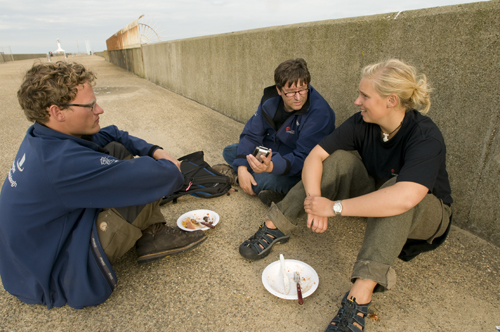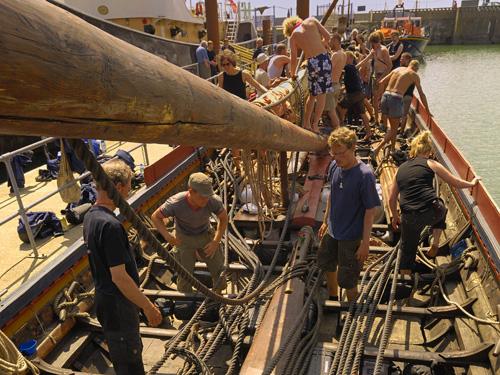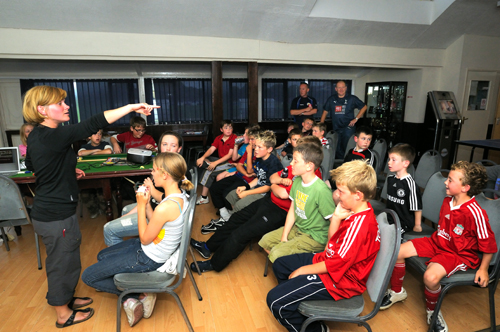Lowestoft, England: Their backgrounds for sailing with the Sea Stallion are very different. Sidsel Romme Nygaard is 21 years old and will start studying political science after the voyage. She has sailed in Viking ships all her life because her parents have been involved in the guild for one of the Viking Ship Museum’s reconstructions, Roar Ege.
Morten Bandelow Winther, a 28-year-old civil engineering student and apprentice carpenter, stumbled upon a summer voyage in a Viking ship last year almost by accident, and there met some hands connected with the Sea Stallion.
Sidsel has sailed with the Sea Stallion since it was launched and she was on half of the voyage last year. Morten’s experience comes from sailing the three weeks and the 635 nautical miles from Dublin to Lowestoft. They both talk about the comradeship, values and experiences that have made the greatest impression and which they hope will form part of the ballast they will take home when the whole adventure ends on 9 August in Roskilde. Let it be said: the Sea Stallion is apparently very addictive – their enthusiasm about being on the voyage seems to know no bounds.
The voyage is a two-year experimental journey from Roskilde to Dublin and back and is the culmination of the largest experimental archaeological project so far in marine archaeology. The total cost, including the reconstruction of the Sea Stallion, has come to DKK 26 million. Danish foundations have therefore been of great importance for carrying out the project. Every time Sidsel and Morten are at sea and look out over the gunwale, they can see their life assurance in the form of the support vessel Cable One, which, like a private detective, follows the Sea Stallion like a shadow in case the worst should happen. The Nordea Danmark Foundation donated DKK 3 million in December to charter Cable One and set up a press secretariat on board. More about that later.
Sidsel: “I have followed the construction and testing of the Sea Stallion right from the start, because I have sailed with Roar, which is a reconstruction of Skuldelev 3. I have sailed with that all my life, because my parents were involved in building it. My father worked at the Viking Ship Museum. When they launched the Sea Stallion I knew I had to sail on it. I had my debut on the last three weeks of the voyage to Dublin. This year I’ve been on the whole trip. Being on the voyage last year whetted my appetite.”
Morten: “I was lucky enough to be on a summer voyage last year in a small Viking ship called Skinfaxe. Being on a sailing ship grabbed me immediately. And I thought it was strange that I had lived in a country like Denmark, with water all around us, and I had actually never thought about the sailing opportunities inherent in that. On the Skinfaxe there were several people who had sailed with the Sea Stallion and they spoke about it. That was inspiring and one could apply to join the crew. I applied and suddenly I was here!”
“I was happy and I told everyone,” he adds. “I was sure that they would almost be envious. But most of them reacted by saying: ‘Why the hell are you doing that?’ That surprised me greatly and it still does. I’m not doing this to test my limits; you can do that in so many other ways if you want. I just want to sail on a sailing ship because I’m wild about that.”
On the Sea Stallion you live extremely close to other people. How do you get along with that?
Sidsel: “I was actually concerned about that before the start. How I should tackle it. But in fact it was not a problem for me.”
Morten: “I learnt something new about groups. Previously I have travelled a lot on my own. My impression then was that the smaller the group the greater the experience. But the downside of that was that you can’t share your experiences with anyone afterwards, especially when you travel all alone. Here I’m suddenly part of a huge group. And I feel that is really great and I have a lot of people I can share my experiences with. That’s something new and wonderful.
“I have had such great experiences on the trip that have affected me deeply,” he says. “It’s been overwhelming and I have thought how wild it is that I’ve been a part of it. There have been various experiences. Just coming on board the ship for the first time almost swept me off my feet. It was much bigger than I had expected. And then there was the long stretch down to Land’s End, when we crossed the Celtic Sea.
“At that time I was completely exhausted, but still fully aware. In fact, my senses opened up and I was really fully present there. I stood there struggling to keep my balance in the high sea. I listened, I sweated at the pumps, I froze in the wind. The sounds were violent, the ship vibrated, the wood gave and creaked. I stood there and said to myself: ‘This is too much.’ It’s hard and wonderful at the same time. There’s no doubt that I’ll remember those moments for years to come.”
Have any good friendships developed among the crew?
Sidsel: “Absolutely. For example, I am now living with a girl I met on the Sea Stallion. So I have made a real friend. But there is a strange difference between life at home and here. Here, the experiences are so intense, relatively fleeting, and completely detached from the rest of your life.”
Do you live very intensely on the Sea Stallion?
Morten: “Quite definitely. That is underlined by the fact that we live a very limited life here. I always used to read the news when I travelled alone before. I went to an Internet café here in Lowestoft today to find out what has happened at home. I’ve already forgotten what I read. It’s as if the world about us suddenly doesn’t interest me any more. I’ve never experienced that before. I have enough in this ship and these people.”
Sidsel: “I certainly agree that this experience is so engrossing that interest in the world around us falls sharply.”
You are challenged in many areas, both psychologically and physically. What does that mean?
Morten: “The physical challenges have not been anywhere near as hard as I had imagined.”
Sidsel: “Yes, that’s all right for you. Try asking the foreship crew how they see things!”
Morten: “Yes, OK, that’s probably quite different.”
Sidsel: “But, fundamentally, you’re right. The physical challenges are nothing I think much about. There will only be a few times in the course of the six weeks we are away that we really get challenged physically.”
Morten: “Agreed, the physical extremes are just a small part of it all.”
Sidsel: “Actually, most of the time sailing is so quiet that we try to find ways to pass the time while we speed ahead for hours on end. We have to talk to each other a lot. And we do talk to each other all the time, often about the most everyday things like the food, the cold and the wind.”
Morten (with a foxy smile): “May I just say that I haven’t found it difficult to pass the time because I brought a very thick book with me!”
Sidsel: “I bet you haven’t read much of that!”
Morten: “No, I definitely haven’t. It’s completely crazy. People said to me there’ll be many long hours of waiting, and I thought that I’d better take something to read with me. But actually I haven’t read a single line of that book.”
Why not?
Morten: “Because it isn’t that difficult to get the time to pass. We talk the hind leg off a donkey and want to be with each other all the time.”
Sidsel: “There are always new people you can be with, if you want to do that. And I want to be in contact with everyone. If I’m sitting beside someone who’s laughing, then I’m there immediately, wanting to be a part of it. And they laugh often and much on board this ship.”
Does the situation help create openness towards others?
Morten: “You learn to accept everybody. You can’t pick and choose. That’s not how it works.”
Sidsel: “I have at least learnt that everyone has some good sides. It’s not like at home, where you can end up rejecting some people because the first impressions aren’t particularly positive.”
Do the façades fall when you live together like this?
Morten: “You simply cannot keep up a façade 24 hours a day, seven days week for six weeks. You can do it home in your job or your course, but not here. I tried to prepare myself for this before I came. Others must judge whether I succeeded.”
Sidsel: “I don’t see anyone any more who goes around with a mental façade. Nor can we hide behind our appearances. For example, we don’t have many clothes. Look at my trousers. They haven’t been washed yet on the whole trip. And I probably don’t smell very good. But nobody says anything because we’re all in the same boat. And when we go to the pub, we all go in the same clothes and we are completely indifferent to what other people think, because we don’t mind how we look, how we are, or how we smell.”
External appearances don’t matter?
Sidsel: “That’s more or less true, but just look at Morten. He shaves quite often. But I bet he can’t keep that style up for another three weeks. But you’re right, external appearance becomes less important.”
Morten: “Let’s see how it goes with the beard. It might perhaps be more interesting to round this off with our toilet. There are incredibly many people who ask if doing it behind a thin tarpaulin very close to other people isn’t a problem. But people very quickly got completely used to the privy.”
Sidsel: “Yes, and now people stand and talk to you while you’re sitting on the john. And they can hear everything that goes on in there.”
Morten: “Yes, and smell it.”
Sidsel: “Yes, and now we don’t care, but our visitors are of course quite occupied by it. But personally I get more questions about what it is like being a woman on board such a ship. I have experienced absolutely no form of chauvinism on board. So the problem is really not of interest and when people interest themselves in it, it is because they think that women have a little less strength than men. But that isn’t a problem as long as you ensure you’re in good form. The Sea Stallion doesn’t demand an enormous physique.
"The craziest thing I’ve heard to date was an Irishman who asked me: ‘What’s a lady like you doing on a ship like that?’!”
As mentioned, all these experiences for two young people on their way in the world would have been nothing without the support vessel paid for by the DKK 3 million donation from the Nordea Danmark foundation in December.
The press secretariat asked the fund’s director, Torben Klein, whether he believes, from the fund’s point of view, that donating the money was a sensible decision when he reads the young people’s account of the project and the importance it has had in their lives:
“Sidsel and Morten’s account of their experiences on board the Sea Stallion show that it has been a fantastic experience being on this voyage. At many levels, they have learned something about themselves and the world about them, which you have to get away from the humdrum of everyday life to experience. If just most of the participants on the voyage have benefited like that, then it was well worth all the money.
“To that should be added the fact that the voyage also is a research and educational project. In itself it is fantastic that, with the Sea Stallion, it has been possible to test archaeological theories and generate a better factual basis for understanding the Viking ship finds and one of the most important aspects of the Viking Age – their ability to sail around in large parts of the northern hemisphere.
“All those of us who haven’t been on board, but must ‘make do’ with standing on the quay when the Sea Stallion arrives back, can look forward to learning more at the Viking Ship Museum in the coming years, as the experiences are processed and communicated,” says Torben Klein.
Facts:
Nordea Danmark-fonden supports activities that promote a good life – i.e. activities that are ‘sound for the soul and/or the body’.
The foundation focuses its donations on activities within the following themes:
• Health and nourishment – promoting health, prevention, nourishment, gastronomy
• Nature and the environment – experiences in nature, conserving nature, water and climate
• Culture – cultural history, art, future-oriented cultural activities
• Sport and exercise – exercise, broad-interest sports and outdoor life
• Education, research and innovation – in particular within the four above-mentioned themes


